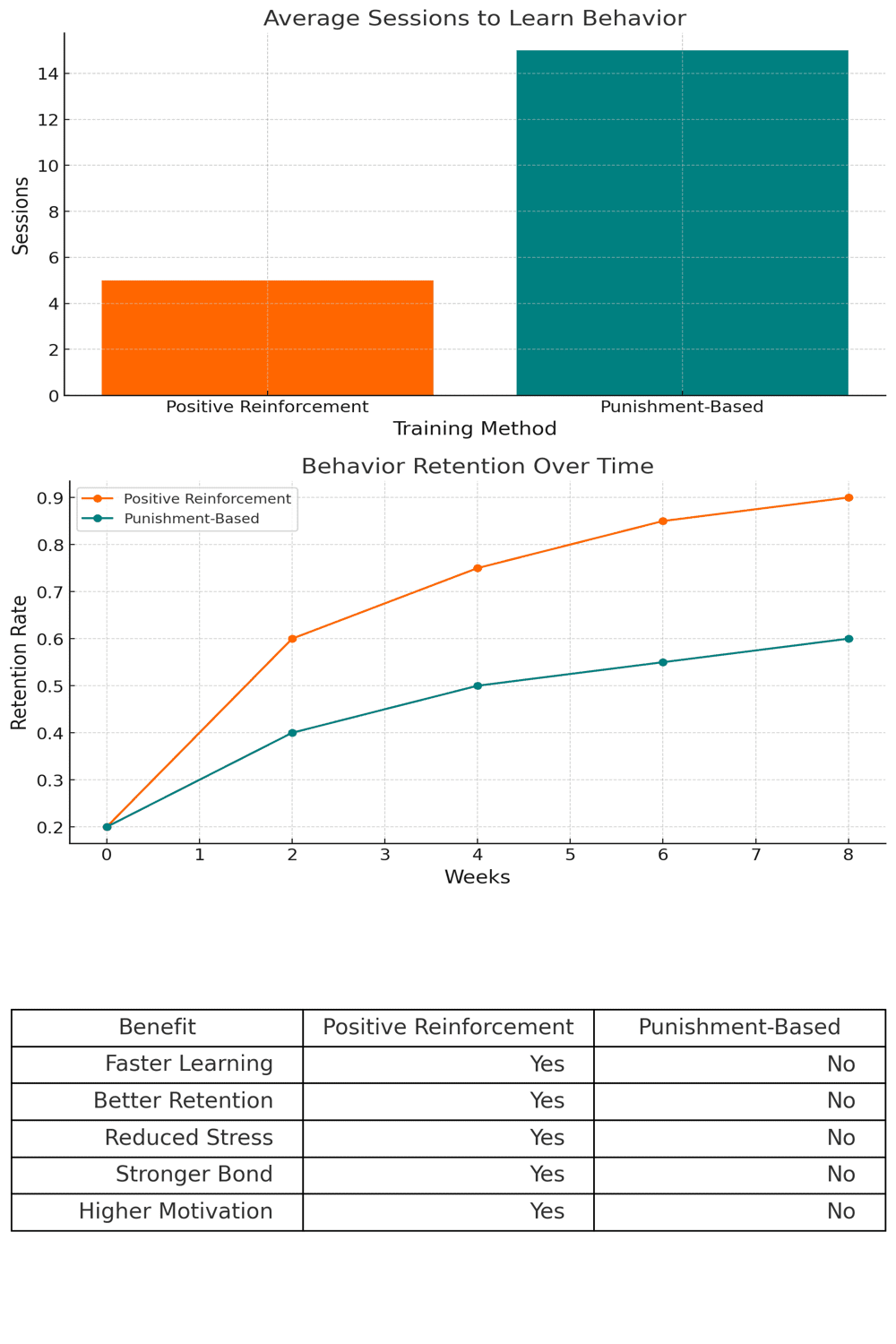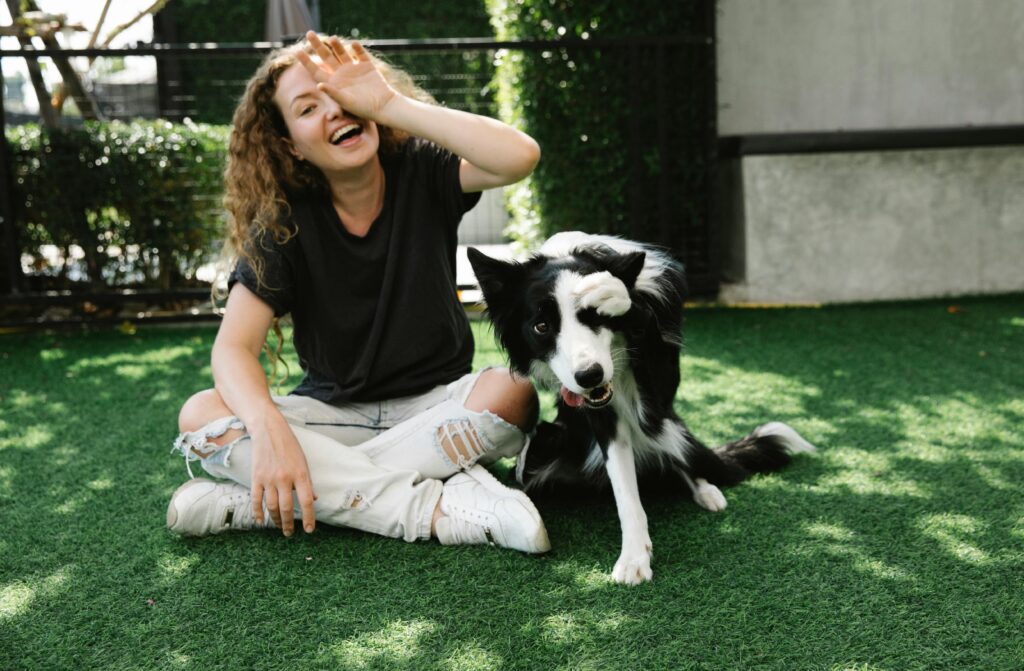
Training a dog is both an art and a science. While various methods exist, the Science Behind Positive Reinforcement in Dog Training has garnered significant attention for its effectiveness and humane approach. This article delves deep into the principles, benefits, and practical applications of positive reinforcement in canine training.
Understanding The Science Behind Positive Reinforcement in Dog Training
When it comes to shaping a dog’s behavior, not all training methods are created equal. To truly transform how your dog learns and behaves, you must first understand the science behind positive reinforcement in dog training. This isn’t just about tossing treats—it’s a proven behavioral strategy grounded in decades of psychological, neurological, and real-world evidence.
🔍 What Is Positive Reinforcement—In Scientific Terms?
Positive reinforcement is a principle from operant conditioning, developed by psychologist B.F. Skinner. In this model:
- Positive means something is added
- Reinforcement means the behavior is more likely to occur again
So when your dog sits, and you add a treat, praise, or play session immediately afterward, you’re practicing positive reinforcement. Over time, the dog’s brain forms strong associations:
“Sitting gets me rewards → I should sit more.”
This process forms the reinforcement loop—a powerful neurological feedback system. Dogs are constantly learning from consequences. Positive reinforcement simply ensures those consequences are rewarding, predictable, and motivating.
🧠 Neuroscience: Why It Works So Well
🔗 Explore Expert Insights from the AKC
Want to dive deeper into how positive reinforcement works? The AKC breaks it down in their guide to clicker training—an essential technique for marking and rewarding behaviors.
Read the AKC’s Clicker Training Guide →To fully grasp the science behind positive reinforcement in dog training, we need to look at the dog’s brain.
When a dog receives a reward for a behavior:
- Dopamine is released
- Dopamine is the brain’s “yes!” chemical. It boosts learning, attention, and memory.
- The brain forms new synaptic pathways
- These neural pathways “wire together” behavior and outcome. The more often a behavior is rewarded, the stronger the pathway becomes.
- Emotion becomes tied to behavior
- Positive reinforcement doesn’t just train actions—it conditions feelings. Sitting politely no longer feels neutral. It feels rewarding.
This explains why dogs trained with positive reinforcement are often more eager, enthusiastic, and emotionally connected to their handlers.
📦 Crate Training Blueprint: Raise a Calm, Confident Puppy
Struggling with barking, reactivity, or nighttime chaos? The root cause often starts in the home environment. This $7 PDF kit gives you the science-based, emotionally attuned strategy to build calm—one crate session at a time.
👉 Download the Crate Training Blueprint📊 Behavioral Psychology: A Quick Breakdown
Understanding the science behind positive reinforcement in dog training also involves understanding how dogs process consequences.
Here’s how the 4 quadrants of operant conditioning work:
| Quadrant | Example | Result |
|---|---|---|
| Positive Reinforcement | Dog gets treat for sitting | ✅ Behavior increases |
| Negative Reinforcement | Dog’s leash pressure is removed when it heels | ⚠️ Behavior may increase, but under stress |
| Positive Punishment | Dog is scolded for barking | ❌ Risk of fear/avoidance |
| Negative Punishment | Dog loses toy for jumping | ⚠️ Mixed emotional signals |
Among these, positive reinforcement is the most humane, clear, and effective long-term strategy, especially for building trust and reliability.
🔬 Real-World Research: What Studies Say
Scientific studies continually reinforce the value of reward-based training:
- University of Lincoln (UK) found that positive reinforcement training improved obedience and reduced stress indicators, like cortisol levels and displacement behaviors.
- Vieira de Castro et al. (2019) compared dogs trained with punishment vs. rewards. The reward-trained dogs showed fewer stress signals, learned faster, and had better recall in unfamiliar settings.
- AVSAB (American Veterinary Society of Animal Behavior) now formally recommends positive reinforcement as the foundation for all dog training, especially for puppies and fearful dogs.

💬 Common Misconceptions (Debunked)
When exploring the science behind positive reinforcement in dog training, it’s essential to dispel outdated myths:
“It’s bribery.”
Not true. Bribery is used to manipulate before a behavior. Reinforcement rewards after a correct behavior has occurred.
“It doesn’t work on stubborn dogs.”
In fact, stubbornness often stems from unclear expectations or lack of motivating reinforcers. With the right reward and structure, nearly all dogs respond to positive reinforcement.
“You’ll always need treats.”
Nope. Once behaviors are learned, reinforcement can become intermittent and vary in type (praise, play, freedom).
🧩 Real-Life Applications of the Science
Here’s how the science comes alive in training scenarios:
| Scenario | How Positive Reinforcement Works |
|---|---|
| Recall | Dog gets freeze-dried liver every time it comes → Builds a powerful association with the cue |
| Leash Walking | Reinforce every moment the leash is slack → Gradually build a default heel |
| Crate Training | Crate = chicken + calm = comfort → Emotional association drives crate preference |
| Fearful Dogs | Rewarding calm behavior near triggers = emotional counterconditioning |
🔁 Timing: The Critical Variable
A core principle within the science behind positive reinforcement in dog training is timing.
- Reward must follow behavior within 1–2 seconds
- Delay introduces confusion: “Am I being rewarded for sitting… or barking afterward?”
- Use clickers or a consistent verbal marker (“Yes!”) to bridge behavior and reward instantly
🏗️ How to Build Lasting Behavior

According to behavioral science, here’s how to make behaviors stronger over time:
- Reinforce every correct response early (100% reward rate)
- Fade to variable rewards (e.g., every 2nd or 3rd repetition)
- Use jackpot rewards occasionally to keep motivation sky-high
- Generalize behavior in multiple environments to avoid context dependence
Dogs are pattern learners. Once they understand that a behavior is valuable everywhere, it becomes rock-solid.
You now know the answer lies in the science behind positive reinforcement in dog training.
💡 Final Thought
Once you understand the science behind positive reinforcement in dog training, you’ll never go back to outdated methods. You’ll see how learning happens in the brain, how motivation drives behavior, and how trust builds reliability.
Your dog isn’t misbehaving to spite you. They’re communicating, learning, and adapting.
When we reward the good, we grow the bond—and build a dog who wants to listen.
The Psychological Foundations
The Science Behind Positive Reinforcement in Dog Training is underpinned by several psychological principles:
- Operant Conditioning: As mentioned, this involves modifying behavior through rewards or punishments. Positive reinforcement is a key component, focusing on encouraging desired behaviors by offering rewards.
- Classical Conditioning: This involves associating a neutral stimulus with a significant one. For instance, if a dog hears a clicker sound every time it receives a treat, it will start associating the sound with the reward, making the clicker a powerful training tool.
- The Law of Effect: Proposed by Edward Thorndike, this principle states that behaviors followed by satisfying outcomes are more likely to recur, while those followed by unpleasant outcomes are less likely to be repeated.
Neurological Insights into the Science Behind Positive Reinforcement in Dog Training

To fully grasp the effectiveness of reward-based methods, we need to explore the neurological mechanisms that drive behavior change in dogs. The science behind positive reinforcement in dog training isn’t just about treat delivery—it’s about rewiring the brain.
🧠 How the Canine Brain Responds to Rewards
When a dog performs a desired behavior—such as sitting calmly—and is immediately given a reward, the brain responds by releasing dopamine, a powerful neurotransmitter associated with motivation, pleasure, and learning. This surge of dopamine doesn’t just make the dog feel good—it also cements the neural connection between the behavior and its outcome.
In scientific terms, this process enhances synaptic plasticity, which is the brain’s ability to form new connections. Over time and with consistent reinforcement, these neural pathways become stronger and more automatic. This is why dogs that are positively reinforced tend to learn faster, respond more reliably, and exhibit lasting behavioral change.
🧪 Positive Reinforcement Reduces Cortisol
Another critical neurological insight involves cortisol, the hormone released during stress. Studies have shown that aversive training methods (like punishment or correction-based approaches) lead to elevated cortisol levels, which can impair learning, memory, and emotional regulation.
In contrast, positive reinforcement training leads to lower cortisol levels and increases the presence of oxytocin, the bonding hormone. This hormonal shift not only helps dogs feel safer during training—it also strengthens the emotional connection between the dog and the human handler.
🧬 Real-World Implication
This brain-based explanation helps clarify why the science behind positive reinforcement in dog training is so impactful:
You’re not just teaching your dog to “behave”—you’re actually restructuring their emotional and neurological response to the world around them.
Positive reinforcement doesn’t just create obedience—it builds a foundation of emotional safety, trust, and healthy brain chemistry that makes learning natural and enjoyable.
Every click, every treat, and every “Yes!” is a signal to your dog’s brain: “This world is safe, and learning is rewarding.”
Benefits of Positive Reinforcement in Dog Training

Understanding the benefits of positive reinforcement in dog training is key to appreciating why it remains the most widely recommended and scientifically supported method. Unlike punishment-based techniques, which often rely on fear or coercion, positive reinforcement builds a training relationship rooted in trust, clarity, and enthusiasm.
Below are the most impactful benefits—each backed by behavioral science and real-world experience:
✅ Enhanced Learning and Retention
Dogs trained using positive reinforcement learn faster and retain behaviors longer. When a dog receives a reward after performing a behavior—like sitting, staying, or coming when called—the brain creates a strong neurological link. Over time, this repetition leads to automatic, consistent responses.
Unlike aversive methods, which may suppress behavior temporarily but create confusion or fear, positive reinforcement provides clarity and predictability, helping dogs understand exactly what earns the reward.
✅ Improved Behavior Without Fear or Aggression
Positive reinforcement reduces the likelihood of stress-induced behaviors such as growling, biting, or freezing. Instead of punishing undesired actions, this approach focuses on redirecting and rewarding appropriate alternatives.
For example, rather than yelling when a dog jumps, you can teach a “sit for greeting” cue and reward calm behavior—resulting in a polite, emotionally secure dog.
✅ Stronger Human-Dog Bond
When you consistently reward your dog for good choices, you’re doing more than teaching manners—you’re building emotional safety and trust. Dogs begin to see their humans not as unpredictable authority figures, but as reliable partners in a shared learning experience.
This connection translates to better communication, deeper responsiveness, and an overall more harmonious relationship between dog and owner.
✅ Higher Motivation and Engagement
Dogs love games. And positive reinforcement transforms training into one. Whether it’s food, toys, affection, or access to something fun, using what your dog values most increases drive, focus, and enthusiasm during sessions.
Dogs trained this way don’t just “obey”—they offer behaviors eagerly, trying to unlock rewards. This mindset accelerates learning and makes training more fun for both of you.
✅ Adaptability for All Ages, Breeds, and Issues
From timid rescues to high-drive working breeds, positive reinforcement can be tailored to any dog. It works exceptionally well for:
- Puppies: Encouraging foundational behaviors and confidence
- Adult dogs: Rewiring problem behaviors with clarity and consistency
- Fearful or reactive dogs: Changing emotional responses through reward-based desensitization
Even experienced trainers rely on positive reinforcement as the core strategy for behavior modification, sport training, and household manners.
“The Science Behind Positive Reinforcement in Dog Training” proves that dogs don’t just learn what to do—they learn to enjoy doing it, again and again.
Practical Applications of Pisitive Reinforcement in Dog Training

The science behind positive reinforcement in dog training doesn’t just sound good on paper—it works in real-life scenarios across all breeds, ages, and behavior challenges. Whether you’re working with a new puppy or trying to redirect an adult dog’s habits, positive reinforcement offers flexible, effective strategies that make everyday training successful.
Here’s how you can apply this method practically:
🐾 Teaching Basic Commands
Positive reinforcement is the fastest and most reliable way to teach core behaviors like:
- Sit – Reward the moment your dog places their bottom on the ground. Repeat consistently, and soon “sit” becomes automatic.
- Stay – Mark and reward stillness over increasing durations, building impulse control without pressure.
- Come When Called – Create a history of high-value rewards for coming, making recall exciting and dependable.
Each behavior is broken down into small steps, or “successive approximations,” and rewarded along the way—a technique known as shaping. This keeps the learning curve smooth and enjoyable.
🐾 Redirecting Problem Behaviors
Instead of punishing undesired behavior, positive reinforcement allows you to teach an alternative and reward it until it becomes the new default.
Examples include:
- Jumping → Teach a solid “sit for greetings”
- Excessive barking → Reinforce “quiet” with calm attention or toys
- Digging → Redirect to a designated dig pit and reward its use
This strategy doesn’t suppress behavior—it transforms it. You’re showing your dog what to do instead of simply telling them what not to do.
🐾 Crate Training and Housebreaking
The science behind positive reinforcement in dog training is especially powerful when teaching dogs to feel comfortable in crates or to eliminate in appropriate places. Rather than forcing confinement or scolding for accidents, you:
- Reward crate entry and calm behavior inside with treats and praise
- Mark and reinforce outdoor potty trips consistently to build strong habits
This method fosters positive emotional associations and speeds up success.
🐾 Desensitization to Triggers and Fears
If your dog is reactive to noises, strangers, grooming, or the vet, you can use counterconditioning with positive reinforcement to shift their emotional response.
For instance:
- Pair the sight of the nail clippers with a treat
- Reward calm behavior when someone walks past
- Feed special treats during car rides to build comfort
These techniques are evidence-backed and widely used in behavior rehabilitation programs.
🐾 Enrichment and Trick Training
Beyond obedience, the same science powers advanced learning and mental enrichment. Positive reinforcement can be used to:
- Teach tricks like spin, roll over, or play dead
- Build confidence through puzzle games and agility
- Keep high-energy dogs mentally stimulated
Dogs love learning when it leads to good things. And you’ll love seeing their personality bloom in the process.
Positive reinforcement isn’t just a technique—it’s a lifestyle of communication, clarity, and connection that builds well-behaved, emotionally balanced dogs.
Scientific Studies Supporting Positive Reinforcement in Dog Training

The effectiveness of positive reinforcement in dog training isn’t just anecdotal—it’s backed by decades of peer-reviewed scientific research across the fields of animal behavior, veterinary science, and psychology. These studies consistently validate the long-term benefits, behavioral reliability, and emotional well-being associated with reward-based training methods.
Here are some of the most compelling research findings that support the science behind positive reinforcement in dog training:
📊 Study 1: Positive Reinforcement vs. Aversive Methods (Ziv, 2017)
In a landmark meta-analysis published in Journal of Veterinary Behavior, researcher Gal Ziv reviewed numerous studies comparing aversive-based methods (e.g., shock collars, leash corrections) with positive reinforcement techniques.
Key findings:
- Dogs trained with positive reinforcement showed fewer stress signals, such as lip-licking, yawning, and cowering.
- They were more obedient in long-term tests and less likely to develop fear-based behaviors.
- Aversive methods were consistently linked with increased aggression and anxiety.
This study reinforced that positive reinforcement is not only more humane—it’s also more effective in building lasting, stress-free behavior.
📊 Study 2: Stress and Hormone Levels (Vieira de Castro et al., 2019)
A Portuguese research team conducted a controlled study measuring cortisol (stress hormone) levels in dogs undergoing different types of training.
Dogs trained with positive reinforcement:
- Had lower baseline cortisol levels after sessions
- Displayed more optimistic judgment bias (a marker of emotional well-being)
- Formed stronger social bonds with handlers compared to punishment-trained dogs
The conclusion: reward-based training improves both emotional resilience and learning performance.
📊 Study 3: Clicker Training and Retention (Deldalle & Gaunet, 2014)
Published in Applied Animal Behaviour Science, this study examined how dogs retained cues after being trained with either positive reinforcement or mixed (correction-based) methods.
Results showed:
- Clicker-trained dogs retained commands faster and with greater consistency
- They were more engaged during training and required fewer repetitions
- Mixed-method dogs showed signs of confusion and delayed responses
This supports the idea that clear, consistent reinforcement enhances cognitive focus and reduces behavioral conflict.
📊 Study 4: Human-Dog Bond and Reward-Based Training (Rooney & Cowan, 2011)
Researchers at the University of Bristol explored how different training styles affect the dog-human relationship.
Findings revealed:
- Owners who used positive reinforcement reported stronger emotional bonds with their dogs
- Their dogs were more responsive, sociable, and eager to interact
- Punishment-trained dogs were more likely to avoid eye contact and display submission
This directly supports the conclusion that positive reinforcement strengthens trust, cooperation, and communication between dogs and their owners.
🧪 The Broader Consensus
In recent years, organizations like the American Veterinary Society of Animal Behavior (AVSAB), RSPCA, and Humane Society of the United States have released position statements explicitly recommending positive reinforcement as the gold standard in training.
“The science behind positive reinforcement in dog training shows clearly: dogs learn best when they feel safe, encouraged, and rewarded.” – AVSAB Position Statement
📚 Summary: Why the Science Matters
The Science Behind Positive Reinforcement in Dog Training offers a humane, effective, and scientifically-backed approach to shaping canine behavior. By understanding and applying these principles, dog owners can foster a positive learning environment, strengthen their bond with their pets, and promote long-term behavioral success.
- Improves learning speed and retention
- Reduces stress, fear, and aggression
- Fosters trust and emotional well-being
- Is more effective long-term than punishment-based methods
For pet parents who want not just obedience but a joyful, cooperative dog, positive reinforcement isn’t just a preference—it’s a proven path forward.
🐶 Learn the Full Power of Positive Reinforcement
Ready to transform your dog’s behavior with kindness, science, and clarity? Visit our complete guide to Positive Reinforcement Dog Training for beginners.
Go to the Full Positive Reinforcement Guide →